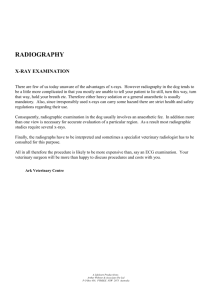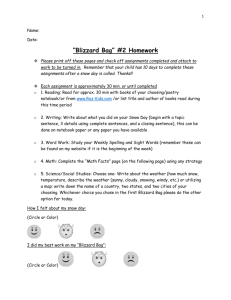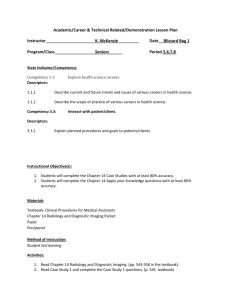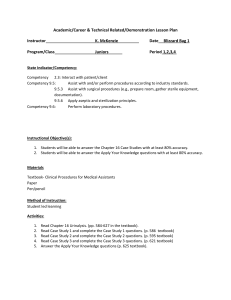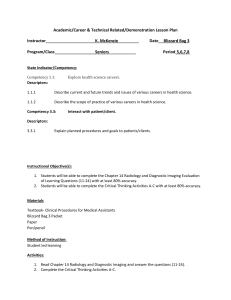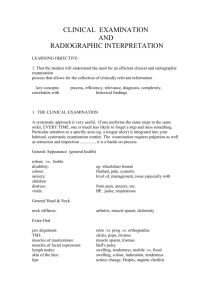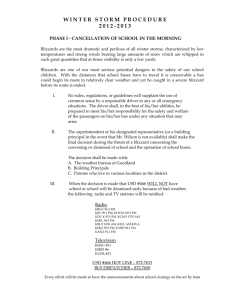Senior Blizzard Bag 2
advertisement
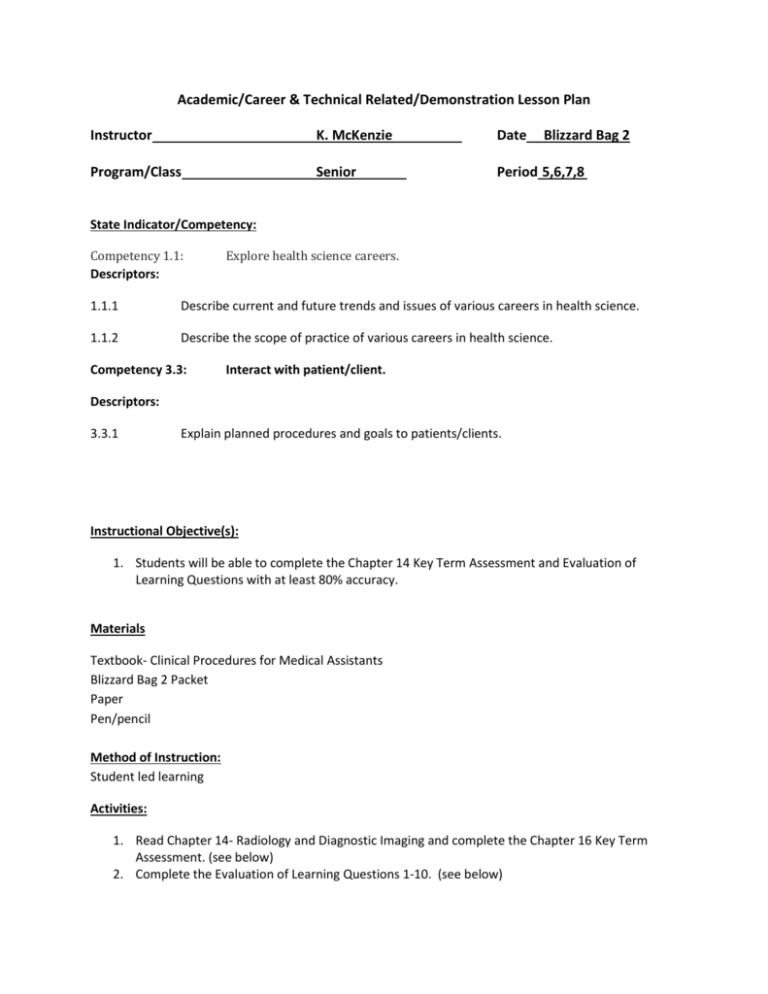
Academic/Career & Technical Related/Demonstration Lesson Plan Instructor K. McKenzie Date Blizzard Bag 2 Program/Class Senior Period 5,6,7,8 State Indicator/Competency: Competency 1.1: Descriptors: Explore health science careers. 1.1.1 Describe current and future trends and issues of various careers in health science. 1.1.2 Describe the scope of practice of various careers in health science. Competency 3.3: Interact with patient/client. Descriptors: 3.3.1 Explain planned procedures and goals to patients/clients. Instructional Objective(s): 1. Students will be able to complete the Chapter 14 Key Term Assessment and Evaluation of Learning Questions with at least 80% accuracy. Materials Textbook- Clinical Procedures for Medical Assistants Blizzard Bag 2 Packet Paper Pen/pencil Method of Instruction: Student led learning Activities: 1. Read Chapter 14- Radiology and Diagnostic Imaging and complete the Chapter 16 Key Term Assessment. (see below) 2. Complete the Evaluation of Learning Questions 1-10. (see below) Closure: Turn in Blizzard Bag 2 on the due date. Assessment: Blizzard Bag 2 SENIOR BLIZZARD BAG 2 ASSIGNMENT 1 KEY TERM ASSESSMENT Directions: Match each medical term with its definition. _____1. Contrast medium _____2. Echocardiogram _____3. Enema _____4. Fluoroscope _____5. Fluoroscopy _____6. Radiograph _____7. Radiography _____8. Radiologist _____9. Radiology _____10. Radiolucent _____11. Radiopaque _____12. Sonogram _____13. Ultrasonography A. A permanent record of a picture of an internal body organ or structure produced on radiographic film. B. A medical doctor who specializes in the diagnosis and treatment of disease using radiant energy such as x-rays, radium, and radioactive material. C. A substance used to make a particular structure visible on a radiograph. D. The record obtained with ultrasonography. E. An injection of fluid into the rectum to aid in the elimination of feces from the colon. F. The branch of medicine that deals with the use of radiant energy in the diagnosis and treatment of disease. G. An instrument used to view internal organs and structures directly. H. Describing a structure that obstructs the passage of x-rays. I. The taking of permanent records of internal body organs and structures by passing x-rays through the body to a on a specially sensitized film. J. Describing a structure that permits the passage of x-rays. K. Examination of a patient with a fluoroscope. L. An ultrasound examination of the heart. M. The use of high-frequency sound waves to produce an image of an organ or tissue. SENIOR BLIZZARD BAG 2 ASSIGNMENT 2 EVALUATION OF LEARNING Directions: Answer the following questions on a separate piece of paper. 1. 2. 3. 4. 5. 6. 7. 8. 9. Who discovered x-rays? What is the function of x-rays? Why is it so important for a patient to prepare properly for a radiographic examination? What is the function of a radiopaque contrast medium? How is a patient positioned to obtain an anteroposterior view? What is the purpose of mammography? Why must the breasts be compressed during mammography? What is the purpose of the upper gastrointestinal (GI) radiographic examination? Why must the GI tract be free of food and fluid before an upper GI radiographic examination is performed? 10. A lower GI radiographic examination assists in the diagnosis of what conditions?
